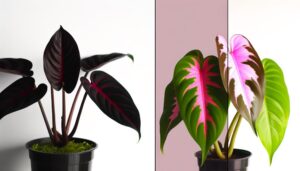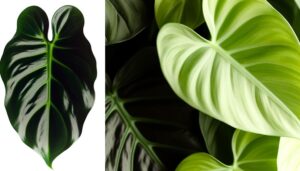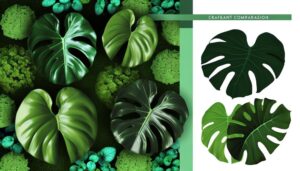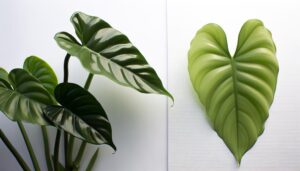Philodendron Gigas Vs Micans: Which is Better?
Philodendron gigas and Philodendron micans, both from the tropical rainforests of Central and South America, exhibit distinct characteristics. Gigas, primarily from Panama, features large, velvety, elongated leaves with deep green and bronze undertones, reaching up to 18 inches.
Micans, native to Mexico and the Caribbean, has smaller, heart-shaped, iridescent leaves with reddish overtones, typically 6 inches long. Gigas is a climbing plant with substantial aerial roots, whereas micans displays a trailing growth habit.
Both require bright, indirect light, high humidity, and well-draining, acidic soil rich in organic matter. Discover more about their ideal growing conditions and aesthetic applications.
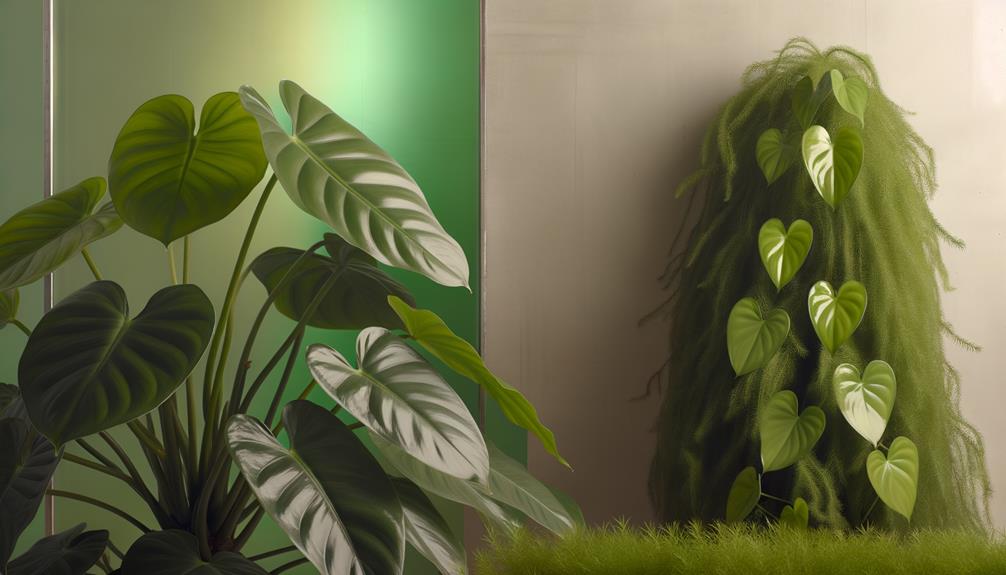
Comparison of Philodendron Gigas and Philodendron Micans
Origin and Habitat
Philodendron gigas and Philodendron micans, two distinct species within the Araceae family, originate from the tropical rainforests of Central and South America, where they thrive in humid, shaded understories. Gigas, primarily found in Panama, exhibits a preference for the lowland rainforests, while micans, native to regions of Mexico and the Caribbean, flourishes in similar humid environments.
Both species are epiphytic, relying on the structural support of host trees to access light and nutrients. The ecological niches they occupy are characterized by consistent moisture levels and dappled sunlight, essential for their growth.
Such habitats facilitate their unique adaptations for water retention and nutrient absorption, making them exemplary models for studying epiphytic plant survival strategies within tropical ecosystems (Croat, 1997).
Leaf Size and Shape
The leaves of Philodendron gigas and Philodendron micans exhibit notable differences in size and morphology. Philodendron gigas presents larger, elongated, and velvety foliage compared to the smaller, heart-shaped, and iridescent leaves of micans.
Philodendron gigas leaves can reach up to 18 inches in length, characterized by their oblong shape and pronounced venation, providing a luxurious appearance. In contrast, Philodendron micans leaves typically measure around 6 inches in length, with a more delicate, cordate form.
This distinction in leaf size and shape can be attributed to their differing ecological adaptations and growth habits. The larger leaves of gigas enable efficient photosynthesis in low-light environments, whereas the compact leaves of micans are suited to climbing and trailing growth patterns.
Color and Texture
Regarding color and texture, the foliage of Philodendron gigas showcases a deep, velvety green hue with a slightly bronze undertone, whereas the leaves of Philodendron micans exhibit a vibrant, iridescent green with subtle reddish overtones and a soft, velvet-like surface.
The unique coloration of P. gigas is attributed to its chlorophyll concentration and anthocyanin pigments, providing a luxurious, textured appearance. In contrast, P. micans’ iridescence results from light interaction with leaf surface structures, producing a shimmering effect.
The tactile experience of both species is equally remarkable: P. gigas leaves feel velvety due to dense trichomes, while P. micans’ leaves are covered in fine, velvety pubescence, adding to their aesthetic and sensory appeal.
Growth Patterns
Philodendron gigas exhibits a robust climbing habit, characterized by its substantial aerial roots that anchor to supports, facilitating vertical growth.
In contrast, Philodendron micans primarily demonstrates a trailing habit, with its slender, elongated stems cascading downwards.
Importantly, the leaf size of Philodendron gigas is considerably larger, often reaching lengths of up to 2 feet, whereas Philodendron micans maintains more modest dimensions, with leaves typically measuring up to 4 inches.
Climbing Vs. Trailing Habit
Distinguishing between the climbing habit of Philodendron gigas and the trailing growth pattern of Philodendron micans requires an understanding of their distinct morphological adaptations.
Philodendron gigas exhibits a robust climbing behavior facilitated by its aerial roots, which latch onto surfaces, enabling vertical ascension. This adaptation is typical of hemiepiphytic plants, allowing them to reach best light exposure in their native habitats.
Conversely, Philodendron micans displays a trailing or vining habit, characterized by stems that elongate horizontally or drape over edges. This trailing tendency is supported by thinner, flexible stems that facilitate spread rather than vertical growth.
These divergent growth patterns reflect their evolutionary strategies for survival and resource acquisition in varying ecological niches (Croat, 1997; Boyce & Brodie, 2013).
Leaf Size Comparison
Leaf size serves as a significant morphological characteristic, with Philodendron gigas producing substantially larger foliage compared to the more modestly sized leaves of Philodendron micans. Philodendron gigas exhibits leaves that can extend up to 2-3 feet in length, demonstrating a remarkable surface area conducive to photosynthesis. This species’ large, velvety, dark green leaves with prominent veins contribute to its striking visual appeal.
Conversely, Philodendron micans features smaller, heart-shaped leaves usually measuring around 3-6 inches. These leaves are distinguished by their velvety texture and iridescent hues, ranging from deep green to bronze.
The difference in leaf size between these two species not only affects aesthetic appeal but also has implications for their respective photosynthetic capacities and ecological adaptations (Boyd, 2019).
Care Requirements
Both Philodendron gigas and Micans require specific care conditions, including ideal light, humidity, and soil requirements, to thrive and maintain their vibrant foliage. Philodendron gigas prefers bright, indirect light, while Micans can tolerate lower light conditions but still benefits from similar lighting.
Peak humidity levels for both species hover around 60-80%, reflecting their native tropical environments (Boyce & Croat, 2011). Soil should be well-draining, rich in organic matter, and slightly acidic, with a pH of 5.5 to 6.5 (Guzmán, 2009).
Regular watering is essential, but the soil must not remain waterlogged to prevent root rot. Fertilizing with a balanced, water-soluble fertilizer every four to six weeks during the growing season supports vigorous growth.
Pests and Diseases
Philodendron Gigas and Micans are susceptible to common pests such as spider mites (Tetranychidae), aphids (Aphidoidea), and mealybugs (Pseudococcidae), which can cause significant damage to their foliage.
Implementing disease prevention strategies, including regular inspection and use of neem oil (Azadirachta indica) or insecticidal soap, is essential for maintaining plant health.
Ensuring ideal growing conditions and proper sanitation practices can mitigate the risk of fungal infections like Anthracnose (Colletotrichum spp.) and root rot (Pythium spp.).
Common Pests Identified
Several common pests, such as spider mites, aphids, and mealybugs, frequently afflict Philodendron gigas and Micans, leading to significant plant health issues.
Spider mites (Tetranychidae) are microscopic arachnids that cause stippling and discoloration by feeding on plant cells, often resulting in webbing on the undersides of leaves.
Aphids (Aphidoidea) are small, sap-sucking insects that can lead to stunted growth and distorted foliage through their feeding activity and the excretion of honeydew, which promotes sooty mold.
Mealybugs (Pseudococcidae) are soft-bodied insects covered in a white, cottony wax that cluster on stems and leaf nodes, extracting sap and weakening the plant.
These pests not only cause aesthetic damage but also serve as vectors for various plant pathogens.
Disease Prevention Tips
Effective management of these common pests and diseases in Philodendron gigas and Micans requires a combination of preventive measures and timely interventions. Regular monitoring and maintaining ideal growing conditions are foundational.
To prevent infestations and disease outbreaks, consider the following strategies:
- Sanitation: Regularly clean leaves with a damp cloth to remove dust and potential pests. Dispose of dead plant material to reduce fungal spore presence.
- Quarantine: Isolate new plants for at least two weeks to guarantee they are pest-free before introducing them to your collection.
- Chemical Treatments: Use neem oil or insecticidal soap as a preventive spray. In case of severe infestations, employ systemic insecticides as per manufacturer’s guidelines.
These steps, supported by scientific best practices, ensure plant health and longevity.
Choosing the Right Plant
When choosing between Philodendron Gigas and Philodendron Micans, it is important to take into account their unique morphological traits and growth needs to guarantee ideal compatibility with your indoor space.
Philodendron Gigas features larger, velvety leaves with pronounced venation, requiring ample vertical space and indirect light (Boyce, 2003).
In contrast, Philodendron Micans has smaller, heart-shaped leaves with a velvety texture and a trailing growth habit, making it suitable for hanging baskets or shelves (Croat, 1988).
Both species thrive in high-humidity environments but differ in their spatial demands and aesthetic impact. Evaluating available space, light conditions, and desired visual appeal will guide you in selecting the plant that best suits your interior setting and horticultural capabilities.
Conclusion
In summation, the Philodendron gigas and Philodendron micans, though sharing a common genus, present a tale of contrasts through their distinct leaf morphology, coloration, and growth habits.
The gigas, with its grand, velvety foliage, evokes images of tropical grandeur, while the micans, with its delicate, iridescent leaves, whispers of subtle elegance.
Their care requirements and susceptibility to pests and diseases further delineate their unique horticultural identities, guiding the discerning enthusiast in making an informed choice.

